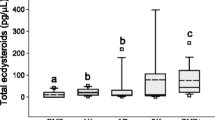Summary
Workers and males of the stingless beeScaptotrigona postica emerge from morphologically similar cells. Normally only one bee is reared in each brood cell, but we found that some of the cells, interspersed throughout the brood comb, contained more than one egg. Because these additional eggs produced adult males, they were probably laid by nurse bees (workers) after the queen had oviposited in the cells concerned.
Although there is no morphological difference between male and worker cells a significant difference was found in the amount of food inside them. The cell where the male is reared shows less food than the worker cell, difference that is statistically significant at 1% level. This fact suggests that: the worker might recognise the cell before oviposition and that this recognition is based on the difference of food quantity.
Resume
Les ouvrières et les mâles deScaptotrigona postica éclosent de cellules morphologiquement identiques. Habituellement, chaque cellule ne contient qu'une seule abeille. Cependant, nos observations montrent que quelques cellules, dispersées sur le rayon à couvain, contiennent plusieurs œufs. Etant donné que les œufs supplémentaires donnent des mâles, ils ont probablement été pondus par des ouvrières nourrices, après la ponte de la reine.
Bien qu'il n'y ait pas de différence morphologique entre cellules de mâles et cellules d'ouvrières, elles contiennent une quantité de nourriture significativement différente. Les mâles sont élevés dans des cellules qui contiennent moins de nourriture que celles où sont élevées les ouvrières: la différence est significative au niveau de 1 %.
Ceci conduit à penser que l'ouvrière pourrait reconnaître la cellule avant de pondre et que cette reconnaissance se ferait à partir de la quantité de nourriture contenue dans la cellule.
Similar content being viewed by others
References
Beig D., 1972.—The production of males in queenright colonies ofTrigona (Scaptotrigona) postica.J. Apic. Res., 11, 33–39.
Defrisse-Gussenhoven E., 1955.—Ellipses équiprobables et taux d'éloignement en biométrie.Bull. Inst. Royal Sci. Nat. Belgique, 26, 1–30.
Dzierzon J., 1845.—Eichstädter Bienenzeitung, 11, 109–113;12, 119–121.
Kerr W.E., Krause W., 1950.—Contribuição para o conhecimento da bionomia dos Meliponini. Fecundação da rainha emMelipona quadrifasciata Lep. (Hym., Apidæ).Dusenia, 1, 275–282.
Kramer C.Y., 1972.—A first course in methods of multivariate analysis. Virginia Polytechnic Institute and State University Polytechnic Institute, Virginia, 351 p.
Levy K.J., 1974.—Testing that k independent random samples were drawn from k normal populations.Psychometrika, 39, 363.
Michener Ch. D., 1974.—The social behavior of the Bees. A comparative study. Belknap Press. Harvard Univ. Press, Cambridge, Mass. 404 p.
Morrison D.D., 1967.—Multivariate Statistical Methods. Mc Graw-Hill Book Co., New York, 338 p.
Moure J.S., Nogueira-Neto P., Kerr W.E., 1956.—Evolutionary problems among Meliponinæ (Hymenoptera, Apidæ).Proc. Tenth Int. Congress Entomol., 2 481–494.
Sakagami Sh.F., Beig D., Zucchi R., Akahira Y., 1963.—Occurence of ovary developed workers in queenright colonies of stingless bees.Rev. Brasil. Biol., 23, 115–129.
Sakagami Sh.F., Zucchi R., 1963.—The oviposition process in a stingless bee,Trigona (Scaptotrigona) postica Latr.Studia Entomol., 6, 497–510.
Velthuis H., 1976.—Egg laying, Aggression and dominance in bees. Proc. XV Int. Congress Entomol., 436–449.
Wilson E.D., 1976.—The insect Societies. The Belknap Press of Harvard University Press, Cambridge, England, 548 p.
Author information
Authors and Affiliations
Additional information
Supported by a grant from Conselho Nacional de Desenvolvimento Cientifico e Tecnológico (CNPq).
Rights and permissions
About this article
Cite this article
Beig, D., Correa Bueno, O., Alves da Cunha, R. et al. Differences in quantity of food in worker and male brood cells ofScaptotrigona postica (Latr. 1807) (Hymenoptera, Apidae). Ins. Soc 29, 189–194 (1982). https://doi.org/10.1007/BF02228751
Received:
Accepted:
Issue Date:
DOI: https://doi.org/10.1007/BF02228751




